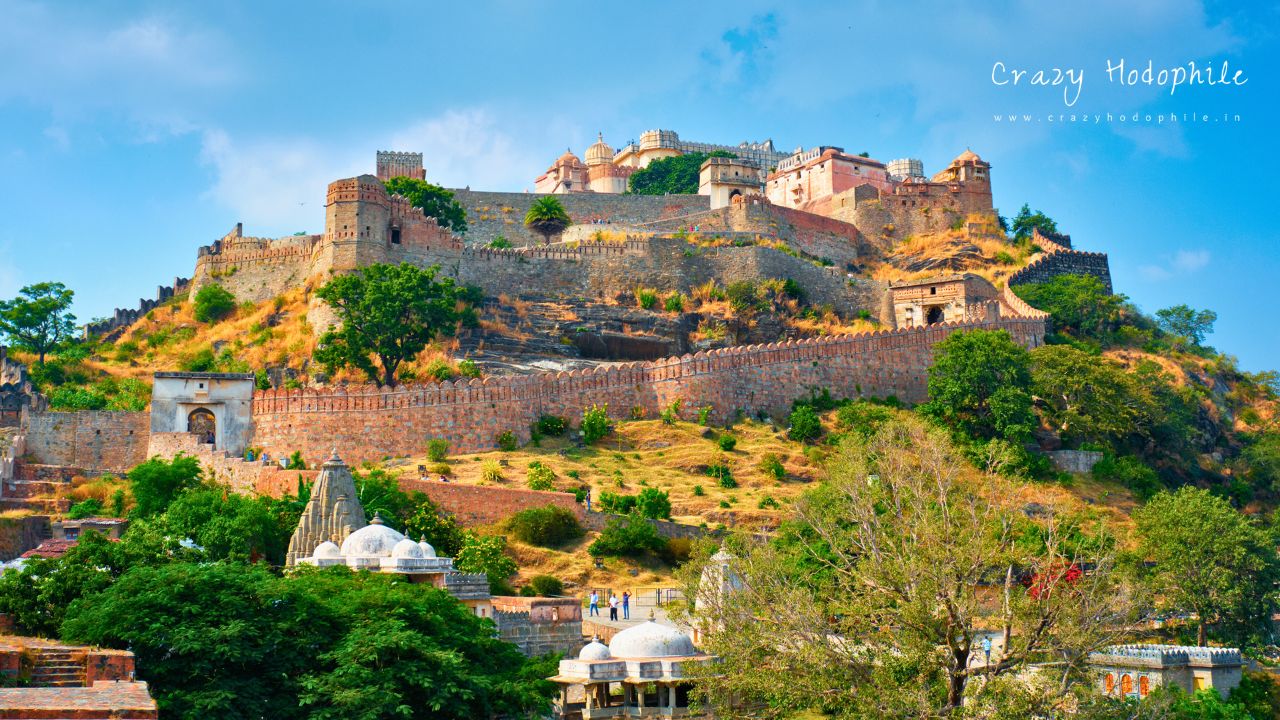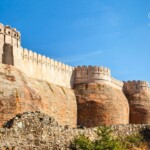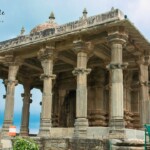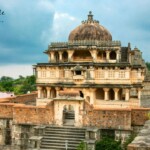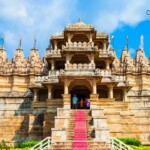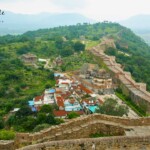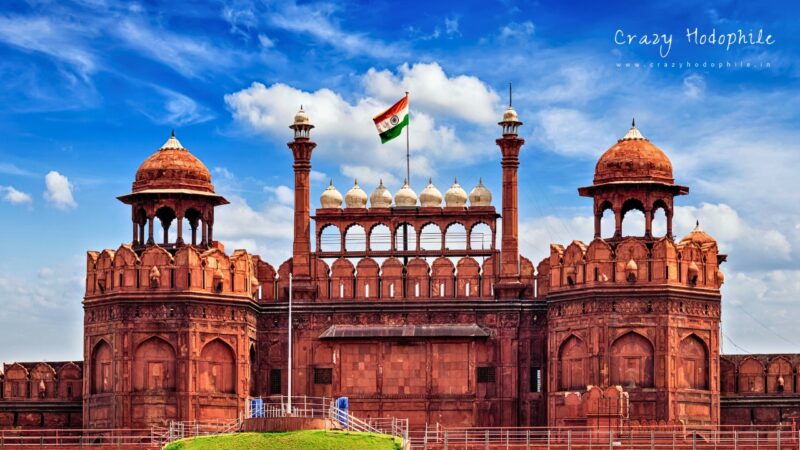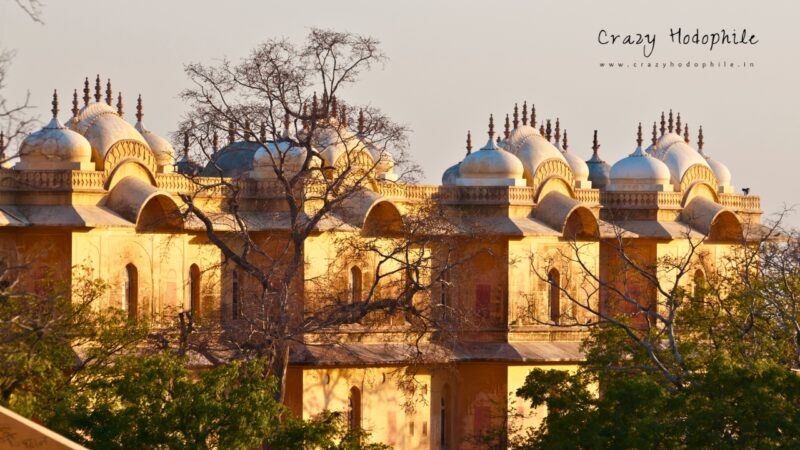Kumbhalgarh Fort: Unveiling the Secrets of Rajasthan’s Fortified Heritage | Crazy Hodophile | 2025
Kumbhalgarh Fort, nestled in the Aravalli Hills of Rajasthan, is a magnificent testament to India’s rich history and architectural brilliance. Renowned for its massive walls stretching over 36 kilometers, it is often called “The Great Wall of India.” This blog serves as your guide to exploring this UNESCO World Heritage Site, covering everything from its fascinating history to practical travel tips.
Table of Contents
Overview of Kumbhalgarh Fort
Built-in the 15th century by Rana Kumbha, Kumbhalgarh Fort is located in the Rajsamand district of Rajasthan. Its strategic location and robust construction made it a safe haven for Mewar rulers during times of conflict. Within its walls, you’ll find 360 ancient temples, palaces, gardens, and water reservoirs, making it a comprehensive historical treasure. It is renowned as the second most significant stronghold in the Mewar region, following Chittorgarh.
Delving into History
The construction of Kumbhalgarh Fort was commissioned by Rana Kumbha of the Sisodia Rajput clan of Mewar in 1443 CE. It served as a refuge for the rulers of Mewar during times of war and played a crucial role in protecting the kingdom.
According to legends, the construction faced several challenges, which were resolved only after a local sage suggested a human sacrifice to appease the gods. The sage himself offered to be sacrificed, and his head was buried where the main gate, Bhairon Pol, now stands. The fort’s construction spanned 15 years, reaching completion in 1458 CE. Rana Kumbha achieved this remarkable feat with the expertise of his chief architect, Mandana, renowned for his mastery in Vastukala (the traditional Indian art of architecture).
Kumbhalgarh Fort, renowned for its strong defences, remained impregnable for centuries despite facing numerous attacks throughout its history. Some notable incidents include:
- In 1457, Ahmad Shah II launched an unsuccessful assault on the fort.
- In 1467, Mahmud Khilji laid siege to the fort, but Rana Kumbha successfully repelled the attack.
- In 1576, after a prolonged siege, the fort was finally captured by Mansingh I, a general serving under the Mughal Emperor Akbar. However, this victory was not achieved by sheer force alone, the Mughals strategically cut off the fort’s water supply, compelling its defenders to surrender.
Gallery
Lesser-known Facts
- Birthplace of a Legend: Kumbhalgarh Fort is the birthplace of Maharana Pratap, the legendary Rajput warrior king known for his bravery and resistance against the Mughals.
- Hidden Escape Routes: The fort features several hidden escape routes that were used during emergencies to ensure the safety of the royal family and its inhabitants.
- Play of Light and Shadow: The placement of structures and windows within the fort was designed to create intriguing light and shadow patterns, particularly during sunrise and sunset.
- Acoustic Wonder: Stand at a specific point near the main gate, and you’ll experience an unusual acoustic effect. Your voice seems to echo and amplify, a quirk of the fort’s architecture.
- UNESCO Recognition: Kumbhalgarh Fort, along with other Hill Forts of Rajasthan, was recognized as a UNESCO World Heritage Site in 2013, highlighting its global cultural and historical significance.
Things to See Inside the Kumbhalgarh Fort
- The Great Wall of Kumbhalgarh: Spanning 36 kilometers, the massive wall surrounding the fort is a marvel of architecture and offers stunning panoramic views of the surrounding Aravalli Hills.
- Neelkanth Mahadev Temple: This ancient temple, dedicated to Lord Shiva, is a spiritual highlight of the fort. The sanctum houses a six-foot-tall Shiva Lingam.
- Ganga Govrdhan Museum: This museum houses a rich collection of ancient artifacts, weapons, paper currency, coins, and sculptures, offering a glimpse into the region’s historical and cultural heritage.
- Ganesh Temple: A temple dedicated to Lord Ganesha, located near the main entrance, is an important religious site for visitors.
- Vedi Temple: Built by Rana Kumbha, this Jain temple is used for ceremonial rituals and stands as a testament to the fort’s religious diversity.
- Mammadev Temple: Situated below the fort, this temple features inscriptions detailing the history of Mewar and nearby cenotaphs of Rana Kumbha and others.
- Badal Mahal (Palace of Clouds): Located at the highest point of the fort, this two-storied palace offers breathtaking views and showcases intricate architectural details, including colorful murals and finely carved windows.
- Kumbha Palace: The residence of Rana Kumbha, this palace reflects the fort’s grandeur with its imposing structure, large rooms, and courtyards.
- Birthplace of Maharana Pratap: Visit the Jhalia ka Malia, the house where the legendary warrior king was born.
- Baoris (Stepwells) and Water Reservoirs: Explore the ingenious water storage systems scattered throughout the fort, demonstrating the self-sufficiency of this massive stronghold.
Visiting Information
Opening and Closing Hours
Open daily from 9:00 AM to 6:00 PM except Sunday.
Ticket Details
- INR 35 for Indian citizens and citizens of BIMSTEC and SAARC countries.
- INR 550 for foreign visitors.
- Entry is free for children aged 15 years and below.
Note: Tickets can be conveniently purchased online through the official website of the Archaeological Survey of India (ASI). The ticket booking window typically opens in the early morning and closes by late evening.
Tickets can be booked through the following link: Archaeological Survey of India
Videography Charge
- Personal use (Handy Camera) – INR 25.
Tips for Your Visit
- Best Time to Visit: The ideal time to explore Kumbhalgarh Fort is between October and March when the weather is pleasant and comfortable.
- Light and Sound Show: Don’t miss the captivating light and sound show that brings the fort’s history to life.
- Wildlife Sanctuary Visit: Explore the nearby Kumbhalgarh Wildlife Sanctuary, which is home to a variety of flora and fauna.
- Parking Challenges: On holidays, parking can be difficult. Consider public transport or plan your visit accordingly.
- Wear Comfortable Shoes: Exploring the entire fort complex involves a lot of walking, so make sure you wear sturdy and comfortable footwear.
- Carry Water Bottle: Staying hydrated is essential, especially during the warmer months.
- Time Allocation: Allocate at least 3-4 hours to thoroughly explore the fort and its numerous attractions.
- Show Respect: Be mindful of the sanctity of the temples and the historical significance of the fort.
- Limited Food Options: Bring your own food for a more convenient experience, as there are limited options near the fort.
Budget Suggestions
- Solo Traveller: ₹1,500 – ₹2,500 per day (including travel, accommodation, food, and entry fees)
- Group Travellers: ₹1,000 – ₹2,000 per person per day (can be more economical when sharing costs)
How to Reach
Nestled in the scenic Rajsamand district of Rajasthan, Kumbhalgarh Fort (PIN Code: 313325) is easily accessible through a variety of travel options. Here’s how:
By Air
The nearest airport is Maharana Pratap Airport in Udaipur, located approximately 98 km from the fort. From the airport, you can hire a private taxi or use bus services for a seamless journey to Kumbhalgarh.
By Train
The nearest railway stations to Kumbhalgarh are Udaipur City Railway Station (85 km) and Falna Railway Station (80 km). From either station, you can hire a private cab or board a bus to complete your journey. The journey by train and road is a visual treat, with picturesque landscapes and winding roads that add charm to your travel experience.
By Road
Kumbhalgarh is well-connected by a network of roads and highways. It is 60 km from Rajsamand, 90 km from Udaipur, and 145 km from Bhilwara. You can travel by government and private buses offering affordable and frequent services, or choose to drive down in your vehicle.
Location Map for Kumbhalgarh Fort
Places to Visit Nearby
- Kumbhalgarh Wildlife Sanctuary (Approx. 2 km): A lush sanctuary surrounding the fort, home to leopards, sloth bears, hyenas, and a variety of bird species. It’s an excellent spot for nature walks, wildlife photography, and jeep safaris.
- Shree Parshuram Mahadev Cave Main Temple (Approx. 9 km): A sacred cave temple dedicated to Lord Shiva, believed to have been built by Parshuram Ji, one of the incarnations of Lord Vishnu. The temple is located amidst serene surroundings and offers a spiritual retreat.
- Hamer Pal Lake (Approx. 9 km): A serene lake surrounded by hills, known for its large population of catfish. You can enjoy the peaceful atmosphere, feed the fish, and even spot some wildlife.
- Ranakpur Jain Temple (Approx. 50 km): Renowned for its intricate marble carvings, this 15th-century Jain temple is a masterpiece of architecture and spirituality.
Related External References:
- Kumbhalgarh Fairs & Festivals
- Improve habitat before designating Kumbhalgarh as tiger reserve
- Pangolin Shows In Kumbhalgarh Sanctuary After 25 Years
- UNESCO declares 6 Rajasthan forts World Heritage Sites
Conclusion
Kumbhalgarh Fort is more than just a historical site; it serves as a gateway to India’s glorious past. With its rich heritage, architectural splendor, and breathtaking views, it offers a unique experience for every visitor. Whether you’re a solo traveler, a history enthusiast, or someone seeking a group adventure, the fort has something for everyone. Plan your visit to this magnificent landmark and immerse yourself in its timeless tales of valor and ingenuity.

